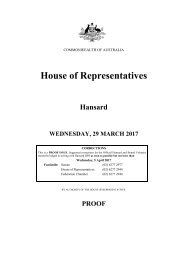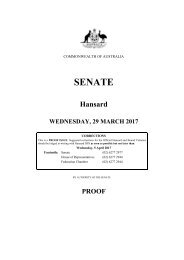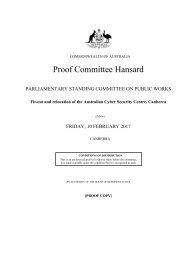SENATE
2mKfSKX
2mKfSKX
You also want an ePaper? Increase the reach of your titles
YUMPU automatically turns print PDFs into web optimized ePapers that Google loves.
Wednesday, 1 March 2017 Senate Page 31<br />
experience in other parts of government is that it can take 12 months just to understand what the problem is, let<br />
alone successfully implement it. When you say it is closed out, can you provide us with some assurance that it has<br />
actually been actioned and the implemented result is achieving what was intended?<br />
Vice Admiral Barrett: It is being actioned. One of the aspects of that in the ICT was identifying those<br />
particular methods by which we will maintain configuration, management, control et cetera throughout each of<br />
the fleets. That identification of the system we will use has been made. That in and of itself sits within the<br />
department's view of where we are going with future ICT reform. But at this moment we are using programs that<br />
have been around for some time—AMS, for instance. Part of the major issue was to assure ourselves that we had<br />
populated AMS with the correct data to the full amount both in breadth and depth. That is still an ongoing issue. It<br />
was always going to be something that was going to take time. The issue for me, though, is that I was not seeking<br />
to measure success by saying that we had 100 per cent in breadth and depth. I wanted to be assured that, as a<br />
result of doing that work, I could assure seaworthiness of the platforms. So it was very much outcome focused. I<br />
am convinced that we are able to demonstrate seaworthiness outcomes even though we are still going through<br />
some of those measures within the ICT roles. But there are measures in place to continue to populate those<br />
particular IT requirements.<br />
Senator FAWCETT: I completely concur—outcome is good. I will come in a minute to some questions<br />
around sea-ready days across the various fleet units. Just on recommendation 14, for example—monitor and audit<br />
technical compliance—I am just after an indication, now that you have that system in place, of whether the results<br />
of that are what you expected. You obviously have had experience with the airworthiness system previously as<br />
you compare what DGTA finds with their audits. Are you finding that Navy is moving toward or reaching some<br />
of the benchmarks of Airforce?<br />
Vice Admiral Barrett: We are in the way that the system works in place. We set out not specifically to copy<br />
the airworthiness regime because there are differences. There were compromises that had to be made given that<br />
the management of technical integrity in the surface fleet is somewhat different from a fleet of aircraft. But part of<br />
the assurance regime included things like seaworthiness boards, raising of corrective action and the management<br />
of those corrective action reports et cetera. All of those things are in place. I am comfortable that we have taken<br />
all of the right steps. What I am seeing is again outcome based—I am seeing people making appropriate riskbased<br />
decisions given the knowledge that they now have. That does not mean that all of our ships have to be<br />
seaworthy all of the time on every occasion. But we have a better understanding of the technical integrity due to<br />
those systemic measures that we have put in place. There are a large number of corrective actions that need to be<br />
made. There are stresses on the system in place in terms of seaworthiness boards and all of the actions that come<br />
out of that. But what I see and what I have absolute confidence in and what I tell the Chief of the Defence Force is<br />
that I have an assurance that we are managing within all of the appropriate tolerances to be able to deliver the<br />
outcome. There is a benefit to doing all of this. That benefit that I see is that we have had a dramatic increase, I<br />
would say, in availability of in particular submarines, which is Coles related, but also with our other platforms at<br />
the moment. As we speak, we have about between 10 and 12 ships off the Western Australian coast performing<br />
an exercise as a task group. We have not seen that for a long time. Availability has improved and I put it down to<br />
improved engineering management.<br />
Senator FAWCETT: That is probably a very good segue. Can you give me a quick summary of what you<br />
have closed out with Coles? My understanding on availability is that late last year you actually had five of the six<br />
Collins class submarines available or deployed.<br />
Vice Adm. Barrett: If I can strip away all of the things that Coles sought to do, it was to demonstrate that we<br />
need to take a fresh look at how we conducted submarine operations at all levels as an enterprise. That is, it was<br />
not just Navy, it was not just CASG or DMO at the time and it was not just industry; it was actually an enterprise<br />
to look at all of it. He did three reports. The first one was I will not say damning, but it clearly pointed to things<br />
that we were not doing. The evidence was obvious—we were not getting submarines to sea at the levels we<br />
needed. His second report a year later, which was about two years ago now, indicated that there were<br />
improvements and we had taken on board the basics. Some of those basics were pretty simple at the end of the<br />
day. He reminded us that we own six submarines. He said that from that you should be able to provide four<br />
submarines to the fleet commander, from which he can deploy two from there. So the other two would be for<br />
training et cetera. He gave us until the middle of 2016 to demonstrate that we could achieve those sorts of<br />
measures as a benchmark. That was for availability. Following through on his measures, closing together on what<br />
was needed from an enterprise, we managed to do that—we met those targets last year in June. Indeed, it is<br />
correct that at the end of last year we had five submarines in the water, but the fleet commander had the four that<br />
were needed and we had two that had been deployed. Indeed, over the last 18 months we have met those<br />
FOREIGN AFFAIRS, DEFENCE AND TRADE LEGISLATION COMMITTEE















